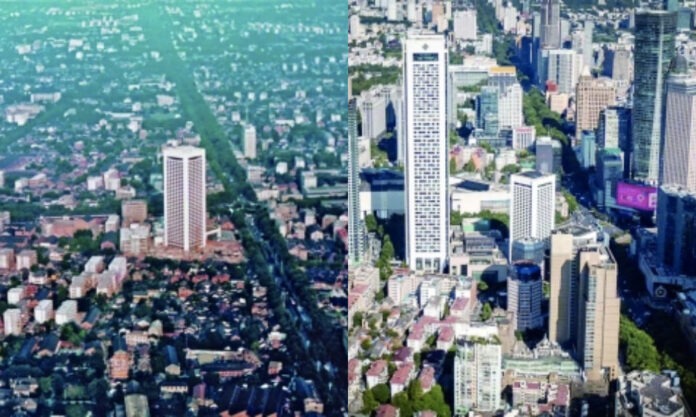Guests checking into the Jinling Hotel in Nanjing these days will notice the 40th anniversary badge imprinted on the card that holds their room key. Some may not, however, be aware that in 1983, this was the tallest building in mainland China.
With the Jinling celebrating this momentous anniversary over the recent National Day holiday, it is therefore worth The Nanjinger checking in on how the iconic, cultural and epicurean hostelry came to be.
Before that, by way of contrast, it should be noted that the Jinling and associated brands today operate in the order of 250 hotel properties in cities across China, as well the Jinling Resort Tianquan Lake, in Xuyi of Huai’an in our very own Jiangsu Province, that has become a benchmark in senior healthcare.
And, back in Nanjing and 2017, the Jinling’s then-recently opened Asia Pacific Tower became the first commercial building in Nanjing to make an annual tax contribution in excess of ¥1 billion.
Cutting to the crux, in March of 1980, ground was broken on what would be the Jinling Hotel in Nanjing’s Xinjiekou. At that point, China’s tallest building was the Shanghai International Hotel, with 24 floors. The Jinling was to far eclipse that, at 37 floors and a height of 110.4 metres.
But even with the first stone about to go in the ground, there was still a question of money, since in the China of those days, there was not so much of it to go around.
In August of 1979, with the vocal, if not financial, support of local officialdom, the Nanjing branch of China International Travel Service (CITS) signed for a US$40 million loan with a company under Singaporean-Chinese businessman, Tao Xinbo. At that time, there were no legal provisions related to guarantees in China, and thus this decision could be thought of as risky. As a result, the Jinling Hotel became the first state-owned enterprise in the country to take on a foreign loan.
There was also a multitude of other problems, as related to the actual physical building, as Nanjing Daily has reported. The effort would involve realising that never before seen in a hotel in China; today seemingly simple things such as a 24-hour per day hot-water supply.
And 3 and a half years later, the Jinling Hotel was not only the tallest building in China, it was also the first with a rooftop helipad, the first with high-speed lifts and the first with a high-rise revolving restaurant.
Over those 40 years, the Jinling Hotel has seen its fair share of the world’s powerful elite walk through its doors and sleep in its beds. Angela Merkel, Chancellor of Germany, was just one; together with Chinese President, Li Xiannian; while 2003 saw the revered Jiang Zemin rest his head at the Jinling and meet with Fidel Castro.
Circling back to its origins, it was in fact China’s modern reformer, Deng Xiaoping, who paved the way for the Jinling to come into being. In 1978, Deng, in a meeting with William T. Seawell, Chairman and CEO of Pan American World Airways (Pan Am) that was also a founding member of the International Air Transport Association (IATA), told representatives of the tourism and civil-aviation departments that their respective industries were very “worthwhile”.
Deng pointed out that it was necessary to use overseas-Chinese and foreign capital to build hotels to speed up the development of tourism. Soon, the State Council approved the construction of the first batch of six hotels in China aimed primarily at tourists. The Jinling Hotel was among them.









